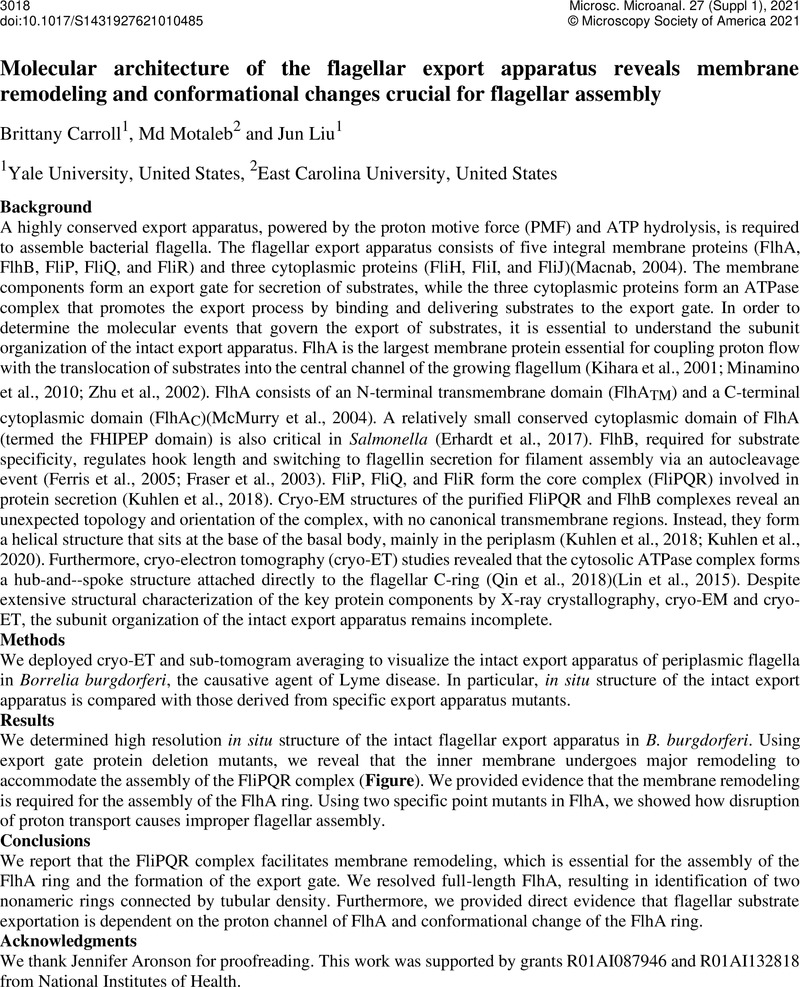No CrossRef data available.
Article contents
Molecular architecture of the flagellar export apparatus reveals membrane remodeling and conformational changes crucial for flagellar assembly
Published online by Cambridge University Press: 30 July 2021
Abstract
An abstract is not available for this content so a preview has been provided. As you have access to this content, a full PDF is available via the ‘Save PDF’ action button.

- Type
- Cryo-electron Tomography: Present Capabilities and Future Potential
- Information
- Copyright
- Copyright © The Author(s), 2021. Published by Cambridge University Press on behalf of the Microscopy Society of America
References
Erhardt, M., et al. (2017). Mechanism of type-III protein secretion: Regulation of FlhA conformation by a functionally critical charged-residue cluster. Mol Microbiol 104, 234-249.CrossRefGoogle ScholarPubMed
Ferris, H.U., et al. (2005). FlhB regulates ordered export of flagellar components via autocleavage mechanism. J Biol Chem 280, 41236-41242.CrossRefGoogle ScholarPubMed
Fraser, G.M., et al. (2003). Substrate specificity of type III flagellar protein export in Salmonella is controlled by subdomain interactions in FlhB. Mol Microbiol 48, 1043-1057.CrossRefGoogle ScholarPubMed
Kihara, M., et al. (2001). Intergenic suppression between the flagellar MS ring protein FliF of Salmonella and FlhA, a membrane component of its export apparatus. J Bacteriol 183, 1655-1662.Google ScholarPubMed
Kuhlen, L., et al. (2018). Structure of the core of the type III secretion system export apparatus. Nat Struct Mol Biol 25, 583-590.Google ScholarPubMed
Kuhlen, L., et al. (2020). The substrate specificity switch FlhB assembles onto the export gate to regulate type three secretion. Nat Commun 11, 1296.CrossRefGoogle ScholarPubMed
Lin, T., et al. (2015). Mutations in the Borrelia burgdorferi Flagellar Type III Secretion System Genes fliH and fliI Profoundly Affect Spirochete Flagellar Assembly, Morphology, Motility, Structure, and Cell Division. MBio 6.Google ScholarPubMed
Macnab, R.M. (2004). Type III flagellar protein export and flagellar assembly. Biochimica et biophysica acta 1694, 207-217.CrossRefGoogle ScholarPubMed
McMurry, J.L., et al. (2004). Analysis of the cytoplasmic domains of Salmonella FlhA and interactions with components of the flagellar export machinery. J Bacteriol 186, 7586-7592.Google ScholarPubMed
Minamino, T., et al. (2010). Role of the C-terminal cytoplasmic domain of FlhA in bacterial flagellar type III protein export. J Bacteriol 192, 1929-1936.CrossRefGoogle ScholarPubMed
Qin, Z., et al. (2018). Cryo-electron tomography of periplasmic flagella in Borrelia burgdorferi reveals a distinct cytoplasmic ATPase complex. PLoS Biol 16, e3000050.Google ScholarPubMed
Zhu, K., et al. (2002). Interactions among membrane and soluble components of the flagellar export apparatus of Salmonella. Biochemistry 41, 9516-9524.Google ScholarPubMed





